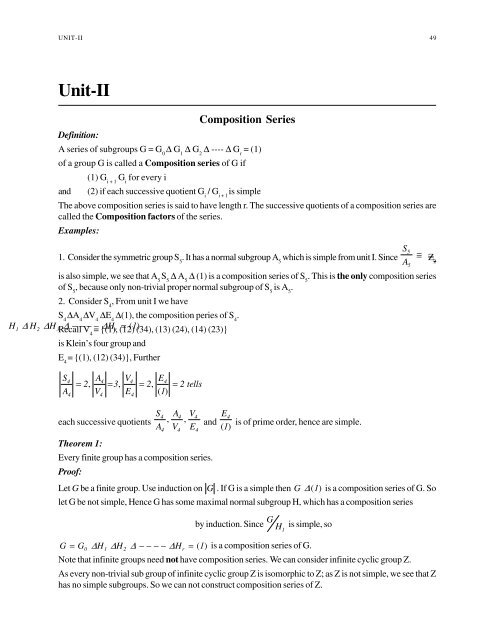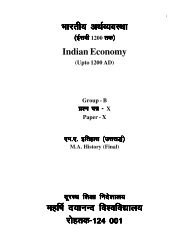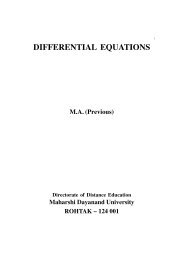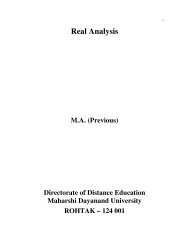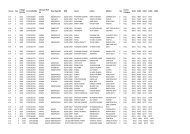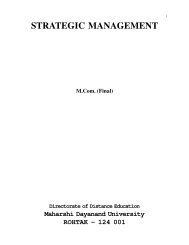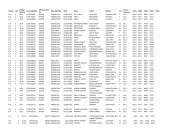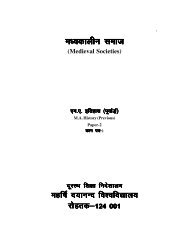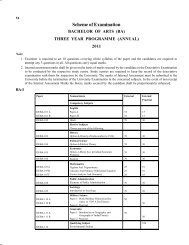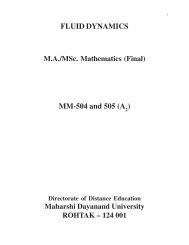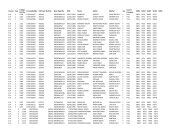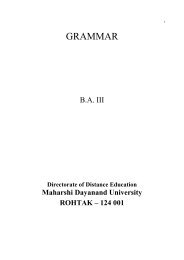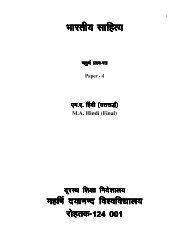Advanced Abstract Algebra - Maharshi Dayanand University, Rohtak
Advanced Abstract Algebra - Maharshi Dayanand University, Rohtak
Advanced Abstract Algebra - Maharshi Dayanand University, Rohtak
You also want an ePaper? Increase the reach of your titles
YUMPU automatically turns print PDFs into web optimized ePapers that Google loves.
UNIT-II<br />
49<br />
Unit-II<br />
Definition:<br />
Composition Series<br />
A series of subgroups G = G 0<br />
∆ G 1<br />
∆ G 2<br />
∆ ---- ∆ G r<br />
= (1)<br />
of a group G is called a Composition series of G if<br />
and<br />
(1) G i + 1<br />
G i<br />
for every i<br />
(2) if each successive quotient G i<br />
/ G i + 1<br />
is simple<br />
The above composition series is said to have length r. The successive quotients of a composition series are<br />
called the Composition factors of the series.<br />
Examples:<br />
≅ Z2<br />
1. Consider the symmetric group S 5<br />
. It has a normal subgroup A 5<br />
which is simple from unit I. Since S 5<br />
A5<br />
is also simple, we see that A 5<br />
S 5<br />
∆ A 5<br />
∆ (1) is a composition series of S 5<br />
. This is the only composition series<br />
of S 5<br />
, because only non-trivial proper normal subgroup of S 5<br />
is A 5<br />
.<br />
2. Consider S 4<br />
, From unit I we have<br />
S 4<br />
∆A 4<br />
∆V 4<br />
∆E 4<br />
∆(1), the composition peries of S 4<br />
.<br />
H 1<br />
∆ H 2<br />
∆H 3 Recall ∆ − −V− 4<br />
= − {(1), ∆H r (12) = ( 1(34), ) (13) (24), (14) (23)}<br />
is Klein’s four group and<br />
E 4<br />
= {(1), (12) (34)}, Further<br />
S4<br />
A<br />
4<br />
A4<br />
V4<br />
E4<br />
= 2 , = 3 2 tells<br />
V<br />
, = = 2<br />
E<br />
, ( 1 )<br />
4<br />
4<br />
each successive quotients S 4<br />
A4<br />
V4<br />
, , and E 4<br />
is of prime order, hence are simple.<br />
A V E ( 1) Theorem 1:<br />
Every finite group has a composition series.<br />
Proof:<br />
4<br />
4<br />
4<br />
Let G be a finite group. Use induction on G . If G is a simple then G ∆( 1 ) is a composition series of G. So<br />
let G be not simple, Hence G has some maximal normal subgroup H, which has a composition series<br />
by induction. Since G H 1<br />
is simple, so<br />
G = G0 ∆H1 ∆H2 ∆ − − − − ∆ H r = ( 1) is a composition series of G.<br />
Note that infinite groups need not have composition series. We can consider infinite cyclic group Z.<br />
As every non-trivial sub group of infinite cyclic group Z is isomorphic to Z; as Z is not simple, we see that Z<br />
has no simple subgroups. So we can not construct composition series of Z.


